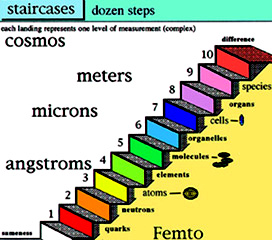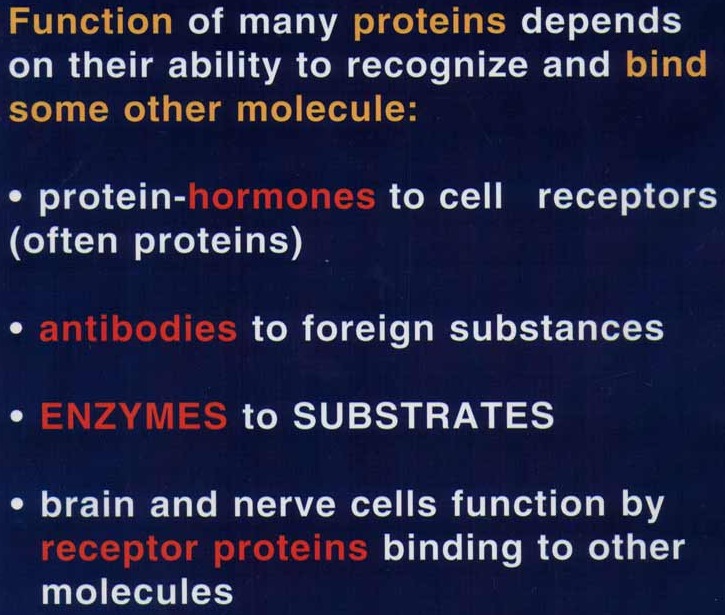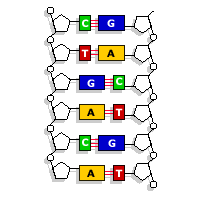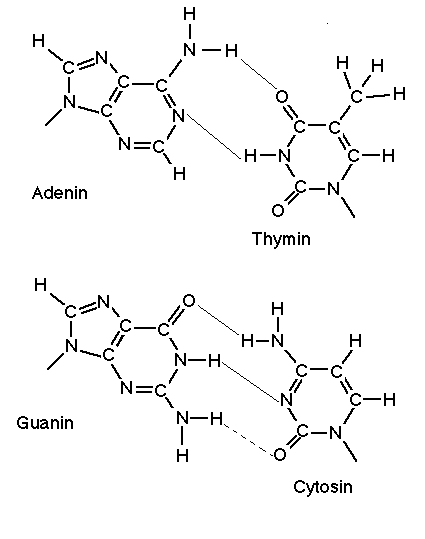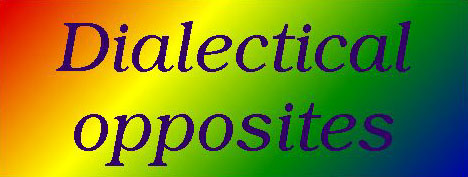 Stairs
of existence
Stairs
of existence
Navigating the site:
Conditions of existence: molecular
![]()
Genetic partners in a mime: deciphering the proteins' meaning.
Proteins | genosystem | hemoglobin | amino acids | N-base pairs | bonding

Confusing at first, the term protein referring to functionally distinct molecules on the cellular level derive from the same root word as proton at the atomic level The root word "Proto" from protean, meaning original substance, suggests that both terms refer to essential ingredients at their respective levels of organization.
macrocosm
cells organelles Proteins molecules atomic elements (bonds) sub-atomic parts microcosm.
genosystem | hemoglobin | amino acids | N-base pairs | bonding
Proteins are created from amino acids in the ribosomes of cells by RNA strands cooperating with enzymes (other proteins) that assemble and construct the sequence of separate amino acid molecules on a chain of amino acids.
Once assembled, the chains of amino acids are folded appropriately (by another enzyme) into the precise shape of the new protein. The order of the amino acids dictates the specific protein to be built. This partnership among proteins and nucleic acids in the cells and on the sub-cellular level causes me to suggest the term "genosystem" when describing the complexity of the gene's many functions.
Of these vital functions, the retention of essential protein construction must be accompanied by conserving the capacity for generating variability.
The term "genosystem" is used to suggest the complexity of feedback response systems and the depth of cooperative functions among enzymes, RNA and the cells organelles (such as ribsomes and golgi bodies) that work in tandem or in a series of preceise maneuvers that regulate the cell's internal conditions of existence and communication with adjacent cells in the tissues of multicellular creatures.
Proteins | genosystem | hemoglobin | amino acids | N-base pairs | bonding
The hemoglobin protein [ depicted above ] that oxygenates (a structure in the protein brings oxyygen to the brain and organs because it binds to molecular oxygen) vertebrate red blood cells is composed of complex molecules and alpha-helices. Shown above, the protein structure can attach oxygen to iron atoms held, in suspension at four areas within this large molecule's precisely folded structure.
It is the shape of the protein that allows molecules within the structure to function and in that manner to assist in the regulation of cells. In this sense the protein molecules are partners with organelles that make up sub-cellular existence.
Proteins | genosystem | hemoglobin | amino acids | N-base pairs | bonding
Proteins are built of Amino acids, by the action of RNA and other proteins. There are only twenty-two amino acids, but they are arranged in a different sequence in the making of over 100,000 proteins. By arranged in a certain order, scientists mean that the sequence of nitrogen base pairs on the DNA or RNA can be translated into one of the 22 amino acids listed in the chart below. WHen arranged in sequence the amino acids create a precise order in a chain of amino acids. This chain forms the basis of a much larger protein which is then folded into a shape that can function in a cell.
U or Uracil in RNA is the equivalent of T or Thymine in the DNA molecule's nitrogen bases.
Amino Acids are built of sequences of nucleic acid, called base pairs. The molecules that make up these base pairs are represented in this diagram by blue spheres:
The double helix of a DNA molecule.
Proteins | genosystem | hemoglobin | amino acids | N-base pairs | bonding
Sequenced base pairs of nucleic acid code for amino acids, such that three nitrogen base pair sequences (trios) match precise amino acidsand no others.
cytosine to guanine
adenine to thymine
Base pairs refer to five nitrogen bases found in the chromatin material of cells. In eukaryotic organisms the chromosomes are in the pouch of the cell's nucleus. The nitrogen base (N-base) pairs are arranged by cellular proteins in a sequence that can be translated by other proteins into an appropriate amino acid, a signal to start to stop transcription, or prion.
These nitrogen base pairs contain to the following molecular components of DNA sequences:
Chemical components
Nitrogen Bases
Adenine and Thymine
Nitrogen Bases
Guanine and Cytosine
The (macro) molecules of DNA and RNA are built up of millions of nitogen base pairs drawn above to identify their atomic elements and hydrogen bonds.
Proteins | genosystem | hemoglobin | amino acids | N-base pairs | bonding
Genetic components: a search for meaning in the microcosmic order of living things.
Century of the Gene, E. F. Keller on the "genosystem." | X in Sex, Bainbridge | The Triple Helix, Lewontin.
